Grýla (The Cannibal Witch of Iceland)
“Meet Grýla, the terrifying Icelandic ogress who hunts naughty children and cooks them for Christmas dinner!”
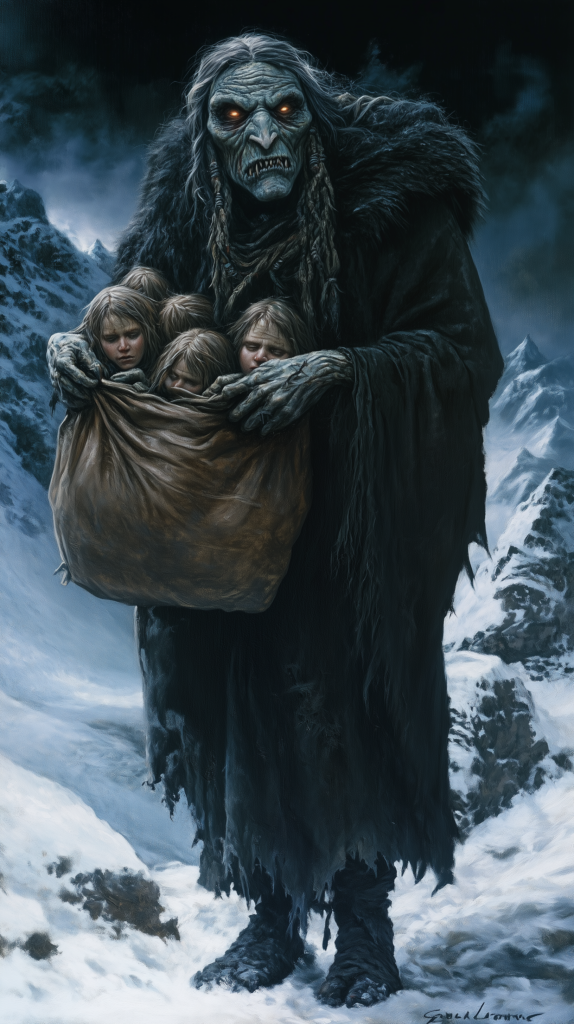
- Alias – The Christmas Ogress, The Child-Eater, The Mountain Giantess
- Gender – Female
- Race – Giantess, Ogress (Supernatural Creature)
- Occupation – Kidnapper of Naughty Children, Enforcer of Moral Behavior, Mother of the Yule Lads
- Religion – None (Folkloric figure, not associated with a particular religion)
- Allies – Yule Lads (Her mischievous children), Yule Cat (who punishes children who don’t receive new clothes for Christmas)
- Enemies – Naughty children (those who misbehave), Parents (in a sense, when their children misbehave), Good-Natured Folk (who oppose her actions)
- Abode/ Base of operations – Dimmuborgir, A cave in the remote, harsh mountains of Iceland
- Nationality – Icelandic (from Icelandic folklore)
- Languages – Icelandic (her story is told in Icelandic folklore, and she is part of Icelandic traditions)
- Alignment – Chaotic Evil (Her actions are driven by a destructive, selfish need to punish and consume misbehaving children)
- Affiliation(s) – None (She operates alone but is symbolically linked with the Yule Lads, the Yule Cat, and the Icelandic Christmas tradition)
- Significant others – Leppalúði (her ogre husband), Yule Lads (Her mischievous children), Yule Cat (who punishes children who don’t receive new clothes for Christmas)
Grýla is a central figure in Icelandic folklore, known for her terrifying and grotesque appearance. She is often depicted as a gigantic, hunched ogress with pallid, ashen skin and a wild, unkempt mane of hair. Her face is monstrous, with glowing eyes that seem to pierce the darkness, a gaping mouth filled with sharp, jagged teeth, and a long, crooked nose. Her body is described as being unnaturally large and misshapen, with long claws that extend from her hands, making her appear even more monstrous and menacing. Grýla’s form is not just intimidating in size but also in the malevolence it exudes, with every aspect of her appearance reinforcing her nature as a creature that evokes both fear and disgust.
Grýla resides in a desolate cave high in the remote, rugged mountains of Iceland, far from human settlements. Her lair is dark, cold, and inhospitable, mirroring her hostile and predatory nature. The cave is described as being isolated from the world, reflecting Grýla’s distance from civilization, and serves as the perfect lair for such a fearsome creature. She is rarely seen outside of the winter months, as that is when she comes down from the mountains to enact her grim deeds.
Grýla is not alone in her cave; she lives with her many children, known as the Yule Lads (Jólasveinar), who each have their own distinct characteristics and behaviors. These mischievous figures are typically portrayed as pranksters who visit children in the days leading up to Christmas, leaving small gifts for the well-behaved and tricks for the naughty. While the Yule Lads are generally less dangerous than their mother, their connection to Grýla reinforces her dominance and the tradition of using folklore to control children’s behavior during the holiday season.
The most infamous aspect of Grýla’s legend is her modus operandi, which is primarily focused on punishing misbehaving children. Every year, as Christmas approaches, Grýla leaves her cave and travels down from the mountains in search of naughty children. Her immense size and cunning allow her to track down those who have disobeyed their parents, failed to follow the rules, or have been particularly bad over the course of the year. Once she identifies her target, Grýla captures the child and drags them back to her cave. The fate of these children is grim: Grýla cooks them in a large pot, preparing them as part of her Christmas feast. She is said to keep the children in a sack or basket before cooking them, emphasizing her role as both a predator and a punishment figure.
Grýla’s motivations are driven by both hunger and a need for control. She is said to possess an insatiable appetite for children, particularly those who have misbehaved. However, her actions also serve as a moral lesson for children in Iceland, reinforcing societal values of obedience and respect. Grýla’s role in folklore is not just as a terrifying monster but as a tool for parents to use in enforcing good behavior. The legend of Grýla thus became a way to instill discipline, with the constant threat of the ogress serving as a warning for children to behave or face her wrath.
Grýla 5e
Leppalúði 5e
Grýla 5e
Grýla Pathfinder
Grýla, The Christmas Ogress
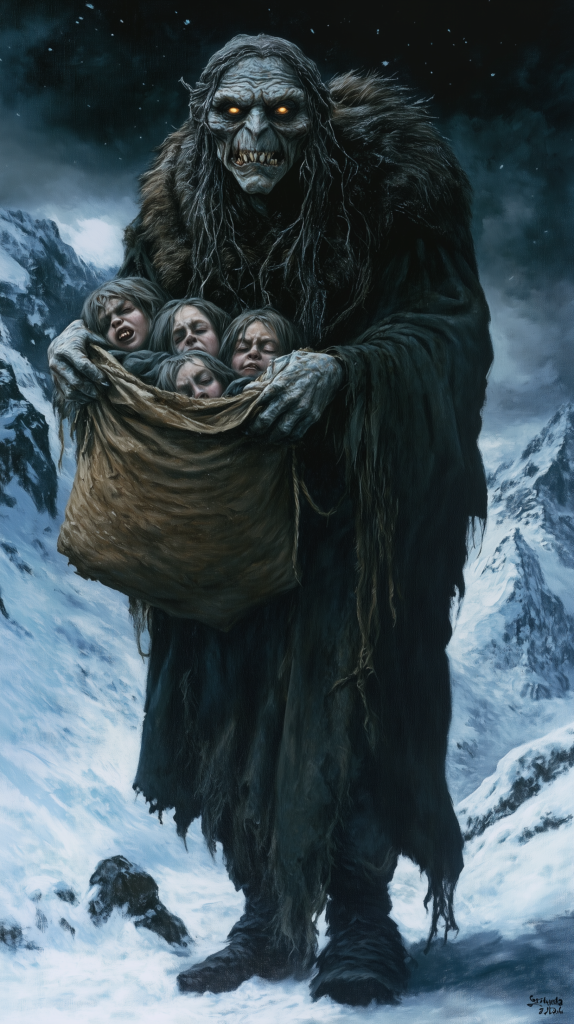
Huge giant, chaotic evil
Armor Class: 18 (natural armor)
Hit Points: 350 (30d12 + 150)
Speed: 40 ft., climb 20 ft.
| STR | DEX | CON | INT | WIS | CHA |
|---|---|---|---|---|---|
| 26 (+8) | 14 (+2) | 22 (+6) | 16 (+3) | 18 (+4) | 20 (+5) |
Saving Throws: Strength +15, Constitution +13, Wisdom +11, Charisma +12
Skills: Intimidation +12, Perception +8, Survival +9
Damage Resistances: Cold, Bludgeoning, Piercing, and Slashing from Nonmagical Attacks
Damage Immunities: Poison, Necrotic
Condition Immunities: Charmed, Frightened, Paralyzed
Senses: Darkvision 120 ft., passive Perception 18
Languages: Common, Giant, Infernal
Challenge: 21 (33,000 XP)
TRAITS
Frightening Presence
As a bonus action, Grýla can choose one creature within 30 feet of her that can see her. The creature must succeed on a DC 20 Wisdom saving throw or become frightened for 1 minute. The frightened creature can repeat the saving throw at the end of each of its turns, ending the effect on itself on a success.
Legendary Resistance (3/Day)
If Grýla fails a saving throw, she can choose to succeed instead.
Innate Magic
Grýla is a natural spellcaster. She can cast the following spells without expending spell slots:
- At will: Detect Magic, Darkness
- 3/day each: Fear, Cone of Cold, Hold Person
- 1/day each: Blight, Ice Storm, Magic Circle (with herself as the center)
Yule Lads’ Aid
Grýla can summon 1d4 Yule Lads (use the stat block of Kobolds but with the Pack Tactics feature replaced by Yule Tactics, where the Yule Lads gain advantage on attack rolls when they are within 10 feet of Grýla). They remain for 1 hour and fight on her behalf. Grýla can summon them as a bonus action, and they vanish when killed or after 1 hour.
ACTIONS
Multiattack
Grýla makes three attacks: one with her Frostbite Claws, one with her Claw Swipe, and one with her Bite of the Beast.
Frostbite Claws
Melee Weapon Attack: +15 to hit, reach 5 ft., one target.
Hit: 35 (4d10 + 8) cold damage. The target must succeed on a DC 20 Constitution saving throw or be paralyzed for 1 minute. A paralyzed creature can repeat the saving throw at the end of each of its turns.
Claw Swipe
Melee Weapon Attack: +15 to hit, reach 5 ft., one target.
Hit: 30 (4d8 + 8) slashing damage. On a critical hit, the target is knocked prone and must make a DC 18 Strength saving throw or be thrown 10 feet in a random direction.
Bite of the Beast
Melee Weapon Attack: +13 to hit, reach 5 ft., one target.
Hit: 25 (3d10 + 8) piercing damage. The target is also grappled (escape DC 20) and must succeed on a DC 18 Constitution saving throw or be poisoned for 1 hour. While poisoned in this way, the creature is incapacitated and cannot take reactions.
Sack of Devouring
Action (One per turn)
Grýla attempts to grapple a creature within 5 feet of her. If she successfully grapples the creature (Escape DC 20), she pulls the creature into her magical sack. While inside the sack:
- The creature is incapacitated and cannot take actions, reactions, or bonus actions.
- The creature can breathe normally, but they cannot take any actions to escape or interact with the outside world.
- The sack can hold up to two Medium creatures or four Small creatures.
The grappled creature can attempt to escape by making a Strength (Athletics) check against DC 20 at the end of its turn. On a success, the creature is expelled from the sack and falls prone in a space of its choice within 5 feet of Grýla.
If Grýla takes damage while holding a creature in the sack, the creature is immediately expelled and falls prone in a space of Grýla’s choice within 5 feet of her.
Note: The sack does not suffocate the creatures inside; it only incapacitates them until they can escape or are released by Grýla.
Ice Shard Blast (Recharge 5-6)
Ranged Spell Attack: +13 to hit, range 60 ft., one target.
Hit: 45 (8d10) cold damage, and the target must make a DC 20 Constitution saving throw or become frozen in ice for 1 minute. A frozen creature is incapacitated, has resistance to all damage, and is immune to all conditions except for paralyzed. A creature can repeat the saving throw at the end of each of its turns, ending the effect on a success.
Chilling Howl (Recharge 5-6)
Grýla lets out a terrifying, supernatural howl. All creatures within 60 feet of her must make a DC 20 Wisdom saving throw or become frightened for 1 minute. While frightened by this effect, a creature must spend its turn fleeing from Grýla as far away as possible. A creature can repeat the saving throw at the end of each of its turns, ending the effect on a success.
LEGENDARY ACTIONS
Grýla can take 3 legendary actions, choosing from the options below. Only one legendary action option can be used at a time and only at the end of another creature’s turn. Grýla regains spent legendary actions at the start of her turn.
- Claw Swipe: Grýla makes one Claw Swipe attack.
- Frostbite Claws (Costs 2 Actions): Grýla makes one Frostbite Claws attack.
- Magical Disruption (Costs 3 Actions): Grýla casts Counterspell or Dispel Magic (choosing which based on her current need).
TACTICS AND BEHAVIOR
Grýla is a strategic and cunning monster, using her Legendary Actions and Innate Magic to control the battlefield. She will often start combat by casting Fear or Cone of Cold to break up formations, forcing enemies into vulnerable positions. Once they are divided, she uses Frostbite Claws to paralyze individuals, making them easier targets for Claw Swipes.
Grýla will summon her Yule Lads to harass spellcasters or weak targets, overwhelming them with numbers. She often tries to grapple smaller or weaker enemies with her Sack of Devouring, effectively neutralizing them and preventing escape. If the battle turns against her, she will use Chilling Howl to create confusion and make her retreat into the mountains.
Her goal is to subdue and capture rather than kill, as she prefers to take children back to her cave for consumption later, but she will show no mercy to those who threaten her directly.
ENVIRONMENTAL TACTICS
Grýla thrives in mountainous, snow-covered terrain. If fighting in such an environment, she will use the terrain to her advantage, hiding in caves or behind snowdrifts to surprise and ambush opponents. Her climb speed makes her an excellent predator in the wilderness. She is particularly adept at using her surroundings to obscure vision and force enemies into disadvantageous positions.
REWARDS
Defeating Grýla might grant characters magical fur cloaks from her clothing, or children’s lost treasures (magical items, trinkets, and possessions she has collected). Her Sack of Devouring may also be a powerful artifact, able to trap creatures inside (though it requires attunement to operate safely).
D&D 5E Epic Monsters: Grýla
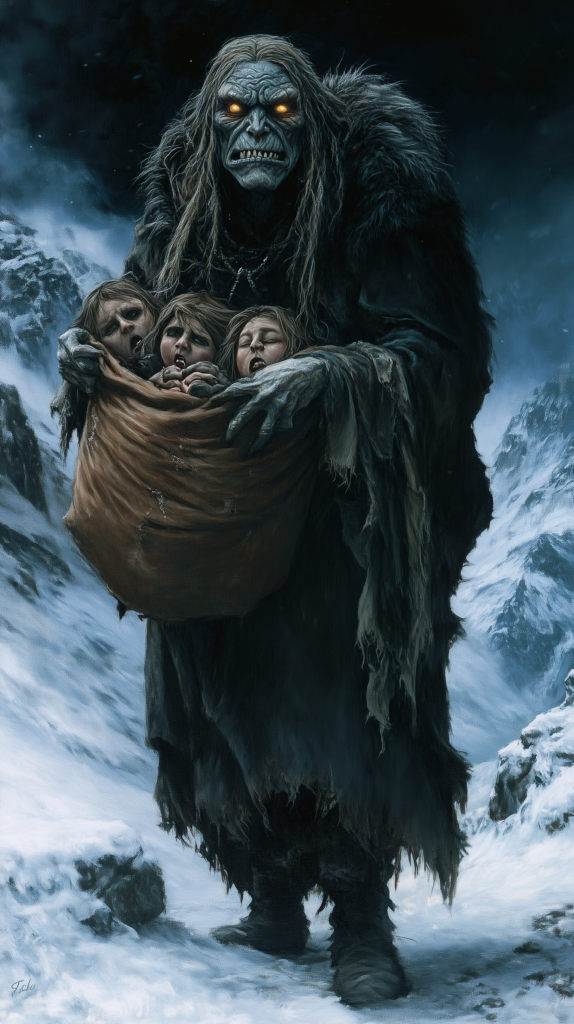
D&D 5E – Epic Monsters: | EN World | Dungeons & Dragons | Tabletop Roleplaying Games
This depiction of Grýla is a forgiving one—this troll is kind of cute, whereas Grýla’s ugliness is one of her most prominent traits no matter which description is being used. Sometimes she’s got 15 tails with 100 balloons tied to each all of which contain 20 children, or instead she has 300 three-eyed heads, or goat horns, eyes on the back of her skull, dangling ears tied to her nose, a bearded chin, and blackened teeth.
The big takeaway is that she is definitely not a looker. In the larger sense she represents the dynamic nature of Iceland: she is the shifting glaciers and volcanic eruptions, the driving force behind the natural phenomena directly affecting peoples’ lives and the terrible burden of winter.
Originally appearing in the 13th century’s Prose Edda, Grýla (loosely translated as “growler”) begins as a beggar seeking out disobedient children, but as time wears on she’s forced out into a cave and by the 17th century (or 19th century, depending on who you ask) gets associated with Christmas. Like the big jolly gift-giving lord of the North Pole, in the minds of many Icelandic children she is very much real and alive today.
Despite being repulsive she has been married three times—first to Gustur who she ate out of boredom, Boli who she bore many offspring from and depending on the tale also ate, and her current husband Leppalúði. Grýla’s children (13 by some counts, 72 by others) are known as Jólasveinarnir, or the Yule Lads, and they have nothing to do with her until she’s tied up with Christmas (same thing with her pet Jólakötturinn the Yule Cat).
Her boys are mischievous in the month of December, going about pulling tricks particular to each (Bjúgnakrækir steals sausages, Hurðaskellir slams doors, Pottaskefill takes leftovers, and so on), although ultimately they get the Santa treatment and either leave a rotten potato or candies in a child’s shoe depending on the kid’s behavior.
Grýla
Huge giant, neutral evil
Armor Class 16 (natural armor)
Hit Points 125 (10d12+60)
Speed 40 ft.
| STR | DEX | CON | INT | WIS | CHA |
| 20 (+5) | 11 (+0) | 22 (+6) | 13 (+1) | 16 (+3) | 5 (–3) |
Proficiency +3
Skills Athletics +8, Perception +6, Stealth +6
Damage Resistances cold
Senses darkvision 120 ft., passive Perception 16
Languages Giant
Challenge 8 (3,900 XP)
Eating Young. When she rolls initiative, roll 1d4. On a result of 4 she has recently eaten a stew made from naughty children, granting her 30 temporary hit points. While she has these temporary hit points, Grýla’s speed is increased by 10 feet.
In You Go. When Grýla has restrained one or more creatures, she can use a bonus action to force them into the enormous sack she carries on her back. A captured creature is blinded and restrained, and it has total cover against attacks and other effects outside the sack. When the sack has taken 30 or more slashing damage (AC 14), creatures inside it can use their reaction to make a DC 16 Dexterity saving throw to escape, exiting prone on a success. At the beginning of Grýla’s turn, any damage dealt to her sack is healed.
Once captured by Grýla’s sack, a creature is released when she wills it or when she dies. Only dimension door and similar teleportation effects that do not require line of sight can be used to exit the sack. When Grýla is slain any creatures captured inside of her sack are no longer restrained by it and can escape using 20 feet of movement, exiting prone.
Keen Smell. She has advantage on Wisdom (Perception) checks that rely on smell.
Nose for Troublemakers. At the start of her turn, she can use a bonus action to peer into nearby souls to see who’s been misbehaving. Grýla instantly learns the names, alignments, and identities of any creatures she can see.
Regeneration. She regains 10 hit points at the start of her turn. If she takes fire damage, this trait doesn’t function at the start of her next turn. Grýla dies only if she starts her turn with 0 hit points and doesn’t regenerate.
Wicked Family. She keeps the enormous black Yule Cat as a pet (Jólakötturinn), she has dozens of sons (the Yule Lads; use the statistics of trolls), and a husband with statistics similar to hers (without this trait, Eating Young, In You Go, or Nose for Troublemakers). These creatures are not calculated into Grýla’s challenge rating.
ACTIONS
Multiattack. She attacks twice.
Claw. Melee Weapon Attack: +8 to hit, reach 10 ft., one target. Hit: 14 (2d8+5) slashing damage. Instead of dealing damage, Grýla can grapple the target (escape DC 16).
Giant Blade. Melee Weapon Attack: +8 to hit, reach 10 ft., one target. Hit: 21 (3d10+5) slashing damage.
Rock. Ranged Weapon Attack: +8 to hit, range 60/240 ft., one target. Hit: 21 (3d10+5) bludgeoning damage.
REACTIONS
Binding Grasp. At the end of a creature’s turn, if it is grappled by Grýla she can use her reaction to make an opposed Strength (Athletics) check to restrain the creature.
Grýla’s Lair: Dimmuborgir
Grýla, her husband, her offspring, and the Yule Cat dwell in Dimmuborgir, a labyrinthine field of lava known.
Regional Effects
The presence of Dimmuborgir has the following magical effects in a 10-mile radius:
- The general temperature of the area is noticeably cooler, and for 10 minutes each night it reaches freezing temperatures even in the summer.
- Creatures have disadvantage on Wisdom (Survival) checks and on Intelligence checks made to remember the paths they’ve taken.
- Creatures have disadvantage on saving throws made against exhaustion.
If Grýla dies, these effects end immediately.
Grýla, Ogress of the Yule Lands
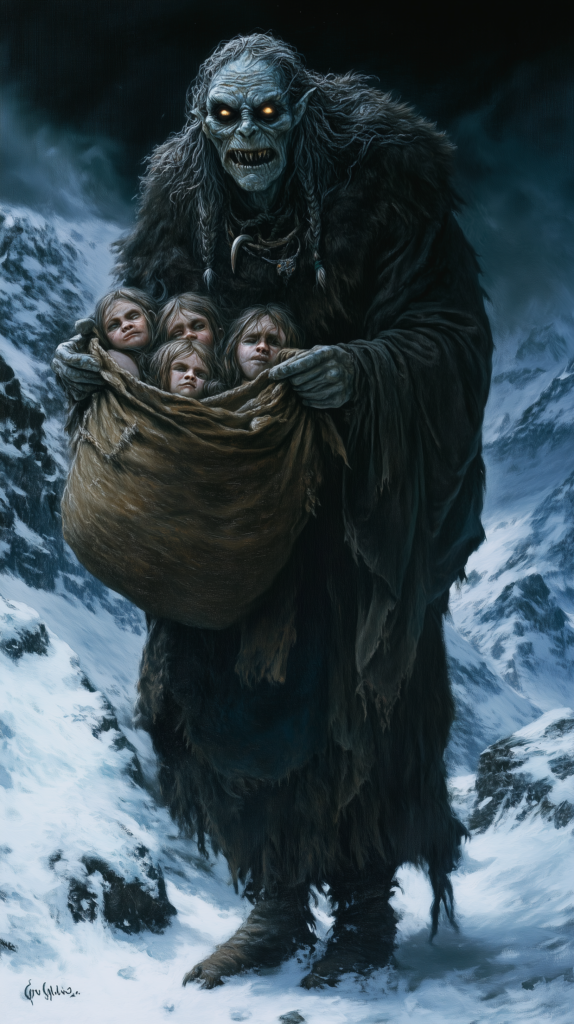
CR: 12
XP: 19,200
CE Huge Giant (Ogress)
Init: +3; Senses: Darkvision 60 ft., low-light vision; Perception +18
AC: 30 (-2 size, +3 Dex, +19 natural); touch 11; flat-footed 27
HP: 210 (12d8+144)
Fort +18, Ref +12, Will +10
Speed: 40 ft.
Melee:
- Claws +18 (2d6+10)
- Bite +16 (1d8+5)
- Sack of Devouring (Grapple) +12 (special)
Space/Reach: 15 ft./15 ft.
Base Attack/Grapple: +9/+23
Special Abilities
- Sack of Devouring (Su): Grýla’s sack is an immense, magical bag capable of devouring those who are unfortunate enough to be caught in it. As a standard action, Grýla can attempt to grapple a target with her sack. A creature grappled by Grýla’s sack is pulled into the bag, where it is trapped in a separate extradimensional space. A creature trapped in the sack is slowly digested unless they succeed on a DC 28 Strength check to escape or a DC 28 Escape Artist check to slip out. The sack has infinite capacity, and creatures trapped inside can breathe, though they cannot attack or cast spells. Grýla can release a creature from the sack as a free action, though she may only hold up to 2 creatures at once.
- Horrific Presence (Su): Grýla’s terrifying appearance and immense size create a powerful aura of fear. All creatures within 30 feet of Grýla must succeed at a DC 21 Will save or become frightened for 1d4 rounds. This is a fear effect. The save DC is Charisma-based.
- Legendary Resistances (3/Day): If Grýla fails a saving throw, she can choose to succeed instead.
- Children’s Feast (Su): Grýla has an insatiable hunger for children. Once per day, she may consume a helpless child (one who is paralyzed, asleep, or bound) as a full-round action, restoring 50 hit points. This is a full-round action, and the consumed child is permanently lost, never to return.
- Yule Magic (Su): Once per day, Grýla can cast summon monster V, but only to summon 1d4 Yule Lads (each appearing as mischievous, troll-like creatures). The summoned Yule Lads obey Grýla’s commands, serving her for 1 hour before returning to the shadows.
- Cold Resistance (Ex): Grýla has resistance to cold damage (30).
- Natural Attacks (Ex): Grýla’s claws and bite are primary natural attacks, and she uses them as part of her full-attack routine.
Spells (Sp)
Grýla is a formidable spellcaster, drawing upon ancient powers connected to winter, darkness, and the creatures of her domain. Her spellcasting ability is based on Charisma (DC 18 + spell level).
Spell-like Abilities (CL 12th):
- At Will: darkness, detect magic, hold person, ray of frost
- 3/day each: cone of cold, fear, ice storm
- 1/day each: cloudkill, dominate person, summon monster VI (to summon a Yeti or Ice Devil)
Statistics
- Str 30, Dex 16, Con 30, Int 16, Wis 14, Cha 18
- Base Atk: +9; CMB: +23; CMD: 35
- Feats: Cleave, Combat Reflexes, Great Cleave, Improved Initiative, Power Attack, Toughness, Weapon Focus (claw), Greater Weapon Focus (claw)
- Skills: Acrobatics +12, Intimidate +20, Knowledge (local) +15, Perception +18, Stealth +11
- Languages: Common, Giant, Infernal
- SQ: Darkvision 60 ft., low-light vision, immunity to fear
Tactics
- Opening Move: Grýla opens combat by using her Horrific Presence to instill fear in nearby foes, followed by using Sack of Devouring to trap enemies or weaklings. She will attempt to use her Sack of Devouring to immediately neutralize anyone she can overpower. She tries to keep the enemy confused by summoning Yule Lads with Yule Magic to harry her enemies with minor magical tricks, pulling attention away from herself.
- In Combat: While the Yule Lads wreak havoc, Grýla will focus on using her Cold Resistance to shrug off any damage from cold-based spells or attacks and her Sack of Devouring to incapacitate foes. She will keep an eye on the battlefield, utilizing Cone of Cold or Ice Storm to hit multiple opponents at once. If she’s cornered, she will use Dominate Person on a weakened target to force them to attack her enemies or assist her in escaping.
- Escaping: If Grýla is overwhelmed or near death, she will retreat into her lair using her Legendary Resistance to overcome a failed save, and may use Cloudkill to obscure her escape. If she cannot escape, she will resort to using Children’s Feast to restore lost hit points.
Environment and Lore
Grýla resides in the eerie volcanic expanse of Dimmuborgir, a harsh region of jagged black rock and frozen tundra, filled with dangerous supernatural forces. Her lair is deep within a network of caves and caverns, where the stench of sulfur and the sounds of the world outside are muffled by the constant hiss of volcanic steam.
Grýla is feared across the land, particularly during the Yule season, when she and her sons, the Yule Lads, roam the countryside looking for misbehaving children. It is said that Grýla and her family were once exiled from the gods for their insatiable hunger and cruelty, but they have since made a home in the shadow of Iceland’s most dangerous mountains and volcanoes.
Her influence extends beyond the physical world; many believe her to be an ancient, primal force tied to the very elements of winter, hunger, and death. Some even worship her, offering sacrifices to avoid her wrath, while others fear her as a harbinger of doom for those who fail to follow the old ways.
Adventure Hooks
- A Child’s Fate: The players must rescue a child who has been kidnapped by Grýla during the Yule season, taken to her lair for her “feast.” The players must navigate the labyrinthine caves of Dimmuborgir to find and free the child before Grýla consumes them.
- Grýla’s Curse: A nearby town has been struck by a strange curse, with children mysteriously disappearing during the winter. The players uncover that Grýla has been taking the children to feast on them. Can they stop her before more are lost?
- Frozen Wastes: Rumors speak of a lost artifact in Dimmuborgir, hidden deep within Grýla’s lair. The players must find and retrieve the item, which is said to possess the power to control the northern winds and bring an end to the harsh winter season—but only if they can survive Grýla’s wrath.
- The Yule Lads’ Trickery: The Yule Lads are wreaking havoc on a nearby village. The players must confront these mischievous beings before they bring the full wrath of their mother down upon the town, and learn the true cost of crossing Grýla.
Final Notes
Grýla is not just a physical threat but a cunning and powerful foe capable of using both brute strength and arcane powers to overwhelm her enemies. Her mythological background and terrifying presence make her a prime antagonist in any cold, dark-themed adventure. Whether as a background menace or a main villain, she brings a unique mixture of mythology, horror, and adventure to any campaign.
Leppalúði, The Ogre Husband of Grýla
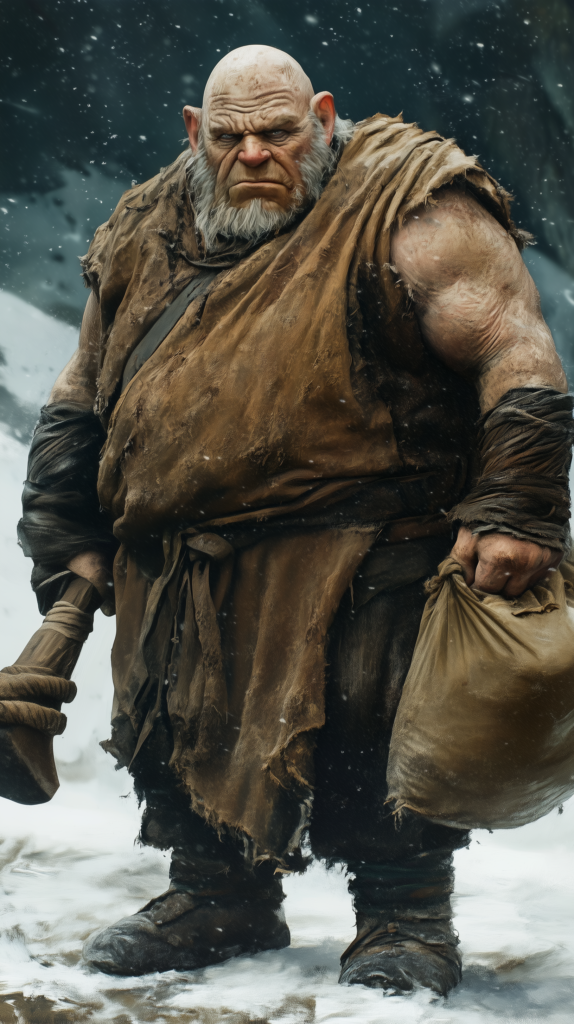
Huge Giant, Chaotic Evil
Armor Class: 15 (natural armor)
Hit Points: 210 (20d12 + 80)
Speed: 40 ft.
| STR | DEX | CON | INT | WIS | CHA |
|---|---|---|---|---|---|
| 26 (+8) | 14 (+2) | 22 (+6) | 10 (+0) | 16 (+3) | 12 (+1) |
Saving Throws: Strength +12, Constitution +10
Skills: Intimidation +5, Perception +7
Damage Resistances: Cold, Fire
Senses: Darkvision 60 ft., passive Perception 17
Languages: Common, Giant
Challenge Rating: 10 (5,900 XP)
TRAITS
- Legendary Resistance (3/Day): If Leppalúði fails a saving throw, he can choose to succeed instead.
- Brutal Strength: Leppalúði’s Strength-based attack rolls and damage rolls are considered to be one step higher (e.g., from “normal” to “great”).
- Ogre’s Endurance: Once per day, Leppalúði can regain 50 hit points as a bonus action. This can only be used if his hit points are below half.
- Terror of the Mountains: Creatures within 30 feet of Leppalúði have disadvantage on saving throws against being frightened.
ACTIONS
- Multiattack: Leppalúði makes two attacks: one with his Mighty Club and one with his Crushing Fist.
- Mighty Club: Melee Weapon Attack: +12 to hit, reach 10 ft., one target.
Hit: 28 (4d8 + 8) bludgeoning damage. - Crushing Fist: Melee Weapon Attack: +12 to hit, reach 5 ft., one target.
Hit: 22 (3d8 + 8) bludgeoning damage. - Stomp: (Recharge 5-6) Leppalúði stomps the ground with tremendous force, causing the ground to shake. All creatures within 20 feet of him must succeed on a DC 18 Dexterity saving throw or be knocked prone and take 15 (2d10 + 4) bludgeoning damage. On a successful save, they take half damage and aren’t knocked prone.
- Hurl Rock: Ranged Weapon Attack: +10 to hit, range 60 ft., one target.
Hit: 22 (3d10 + 8) bludgeoning damage. Leppalúði can hurl large boulders or chunks of the rocky terrain where he resides.
LEGENDARY ACTIONS
Leppalúði can take 3 legendary actions, choosing from the options below. Only one legendary action option can be used at a time and only at the end of another creature’s turn. Leppalúði regains spent legendary actions at the start of his turn.
- Move: Leppalúði moves up to his speed without provoking opportunity attacks.
- Club Strike: Leppalúði makes one attack with his Mighty Club.
- Roar of the Mountains: Leppalúði lets out a bone-rattling roar. All creatures within 30 feet of him must succeed on a DC 17 Wisdom saving throw or be frightened for 1 minute.
TACTICS
Leppalúði, in line with his mythological persona, is not a particularly cunning or strategic fighter, but he is brutally effective. He prefers to rely on his immense physical power and intimidating presence in battle.
- Charge Forward: Leppalúði’s first tactic is often to charge straight into combat, swinging his Mighty Club at anything that stands in his way. If confronted by multiple enemies, he may use his Stomp to knock foes down and create chaos in the battlefield.
- Use of Terrain: Leppalúði often fights in mountainous or rocky terrain, where he can use his environment to his advantage, hurling boulders and causing rockslides to overwhelm his enemies.
- Psychological Warfare: His Roar of the Mountains is a key tactic to frighten enemies and weaken their resolve, especially when facing multiple opponents. His sheer size and demeanor, coupled with his intimidating aura, can make opponents hesitate in fear.
- Durability and Longevity: Leppalúði’s focus is not on speed or finesse but on sheer endurance and brute force. He uses his Ogre’s Endurance to keep him fighting longer than most foes would expect.
BACKGROUND
Leppalúði is portrayed as the silent, brute husband of Grýla. Unlike other ogres or giants, he does not speak much, and his demeanor is one of slow, lumbering malevolence. In many stories, he is described as devoted to Grýla, assisting her in her wicked endeavors, but also embodying the role of a guardian, often watching over the dark places of the earth, especially during the long Icelandic winters.
While Grýla is more notorious for her cruelty, Leppalúði adds an inflexible and relentless nature to their evil partnership. He terrorizes travelers who venture too far into the mountains, and although he has little interest in interacting with others, his violent tendencies make him a dangerous threat. Leppalúði is one who will punish those who defy the old ways of the wilderness and pay homage to the gods of the earth.
His role as a companion to Grýla also makes him more menacing, as he serves as her muscle when she comes down to snatch children and wreak havoc. Where Grýla may have a more manipulative, scheming nature, Leppalúði is more about raw power and brute force, making him a terrifying presence in the stories of Icelandic folklore.
MOTIVATION AND BEHAVIOR
Leppalúði’s primary motivations revolve around serving his wife, Grýla, and maintaining control over his domain. He is easily provoked, especially when it comes to protecting Grýla’s plans or if she is threatened. He is fueled by rage and finds satisfaction in crushing opposition and inflicting terror. In his own way, Leppalúði embodies the unchallenged force of nature—unstoppable and destructive.
His emotions are basic, but they are fueled by a deep loyalty to Grýla. This makes him both a devoted ally and a dangerous enemy. If confronted by threats to their lair or children, he will respond with deadly force, often decimating anything that gets in his way.
Dimmuborgir
“Venture into Dimmuborgir, where volcanic spires, mythical beasts, and Norse legends collide in a hauntingly beautiful, supernatural stronghold!”
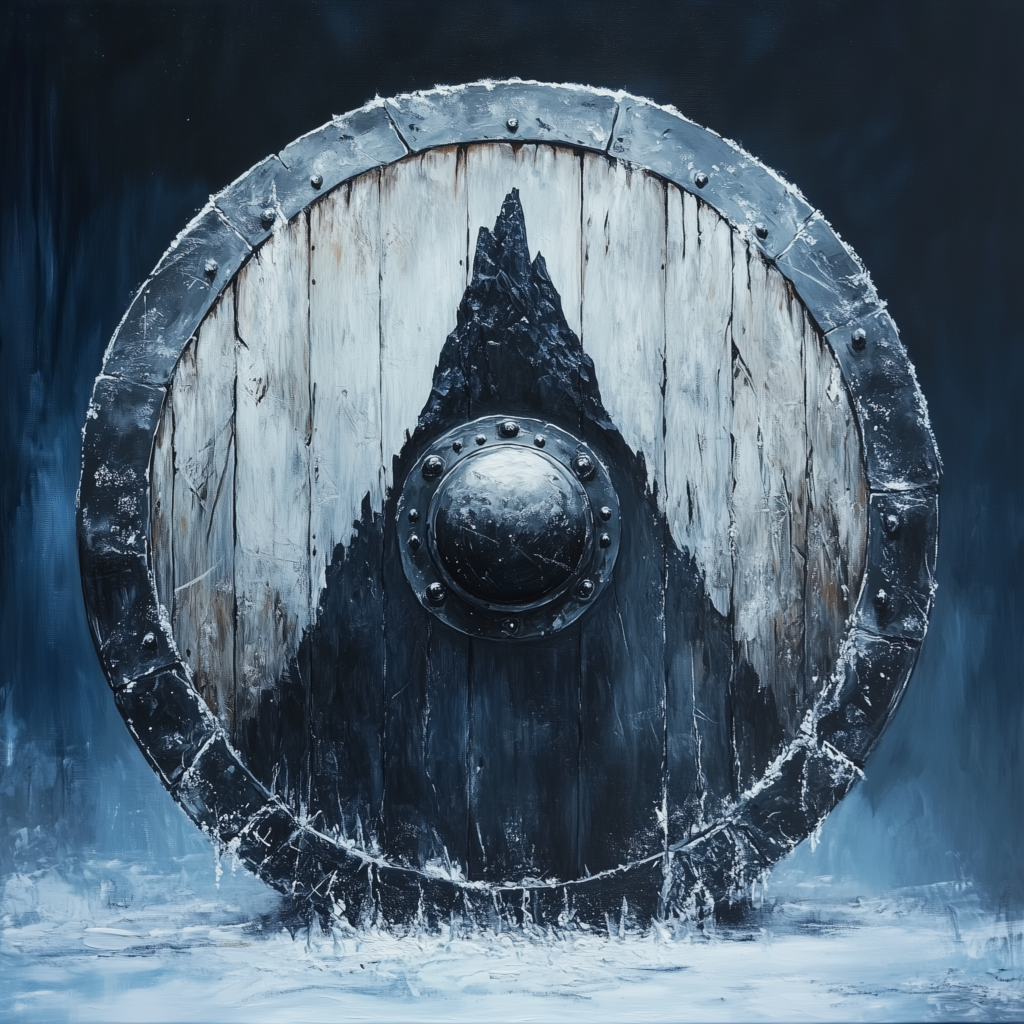
- Coat of Arms/Flag: Black volcanic spire encircled by frost on a dark blue field.
- Motto: “From the Ashes, Ice Prevails.”
- Status: Isolated supernatural settlement.
- General Alignment: Chaotic Neutral, leaning Chaotic Evil.
- Religious Affiliations: Norse paganism, reverence for Hel, Skadi, Loki, and landvættir.
- Capital City: None, but Grýla’s Caverns serve as the central hub.
- Other Settlements: Small villages like Hrafnsvellir and Snjókaldahlíð.
- Common Languages: Old Norse and regional dialects.
- Religion(s): Worship of Hel, Skadi, Loki, and respect for local spirits.
- Demographics: 60% Humans, 25% Jötunn-blooded, 10% Dwarves, 5% Other.
- Government: Tribal council ruled by Grýla.
- Legislature: Customary laws dictated by Grýla’s whims.
- Population: ~300 residents.
Notable Details
- Notable Places:
- Grýla’s Hearth (sacrifice pit).
- Yule Cave (Yule Lads’ lair).
- Trollstone Keep (fortress ruins).
- Current Ruler: Grýla, the Ogress Queen.
- Other Notable Residents: Leppalúði (husband), Yule Lads (sons), Yule Cat.
- Associated Deities/Saints: Hel, Skadi, Loki.
Interactions
- Allies: Frost Giants, other jötunn clans.
- Enemies: Norse priesthoods, nearby villages.
Adventuring Hooks
- Quest Hooks: Rescue a child, sabotage Grýla’s plans, recover artifacts.
- Threats: Supernatural blizzards, Yule Cat, mischievous Yule Lads.
Treasures and Mythical Entities
- Treasures:
- Grýla’s Cauldron (cold resistance).
- Legendary Entities: Yule Cat, jötunn ghosts, Grýla herself.
Nestled in the stark volcanic plains of northern Iceland, near the shores of Lake Mývatn, Dimmuborgir is a settlement unlike any other in the known world. This labyrinthine region of jagged lava formations and deep caves serves not only as a home for the hardy and the outcast but also as a site deeply enmeshed in the spiritual and supernatural fabric of the Norse world. Here, the boundaries between the mortal realm and the domains of gods, spirits, and mythical beings blur, creating a place of profound power, danger, and cultural richness.
Physical Features
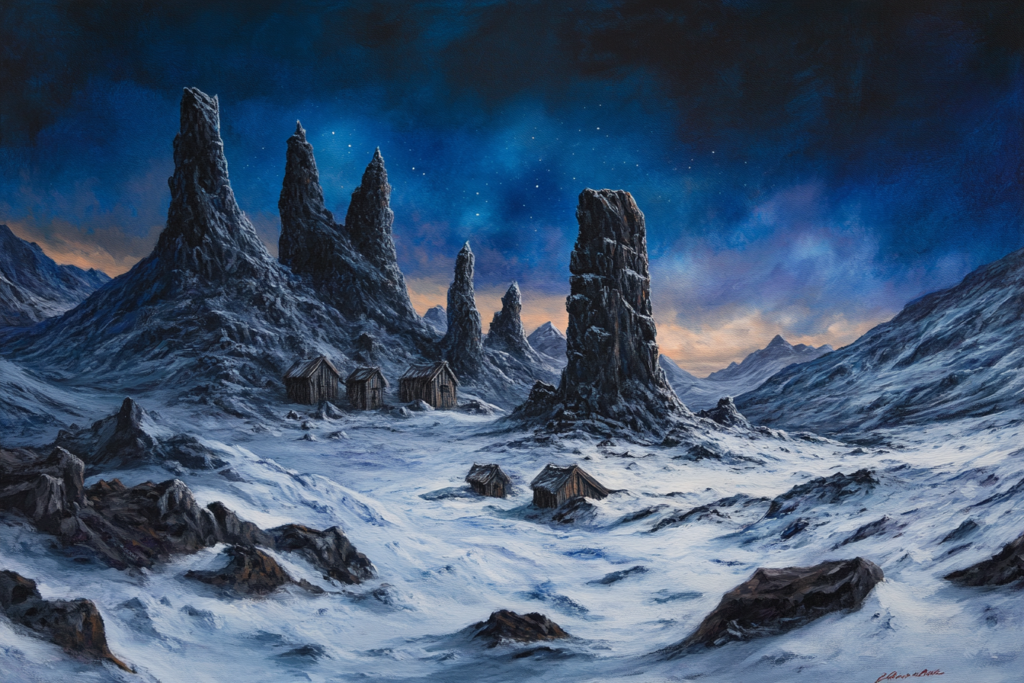
Dimmuborgir’s landscape is otherworldly, sculpted by the forces of volcanic fire and icy winds over millennia. Towering spires of black volcanic rock jut skyward like frozen flames, some reaching heights of 50 feet, their surfaces carved by ancient eruptions. These formations, riddled with caves and tunnels, provide shelter to the settlement’s inhabitants and the creatures rumored to dwell beneath. The labyrinthine terrain, dotted with natural arches and rocky alcoves, gives Dimmuborgir its name: “Dark Castles.”
The ground is a mix of hardened lava, dusted with snow for much of the year, and hardy mosses that cling stubbornly to the rock. Steam vents rise from fissures, shrouding the area in an eerie mist that mingles with the ever-present northern winds. In the dark of winter, the aurora borealis dances above, casting an ethereal glow over the settlement, amplifying its mystical aura.
People and Culture
The people of Dimmuborgir are a mix of settlers, wanderers, and exiles. Many are descendants of those who sought refuge in the harshest lands to escape feuds or persecution. They are a hardy folk, accustomed to bitter cold and privation, yet fiercely proud of their resilience. Most inhabitants live in small stone huts built against the lava formations, reinforced with turf and timber scavenged from distant shores.
Beliefs and Practices
- The dominant spiritual system in Dimmuborgir revolves around Norse paganism, though it has evolved uniquely in this isolated setting.
- Hel, the goddess of the underworld, is venerated as a guardian of the land’s harsh balance between life and death. Offerings are made to her during midwinter to ensure safe passage through the long, dark months.
- Skadi, the goddess of winter and the hunt, is deeply respected. Her followers practice rites that include hunting expeditions into the snow-covered wilds, often donning masks carved from volcanic rock.
- The people also revere landvættir (land spirits) and huldufólk (hidden people), leaving food offerings at rock shrines to maintain their goodwill.
Local Traditions
- Yule Sacrifices: During the winter Yule season, offerings are made at Grýla’s Hearth, a volcanic fissure believed to be the dwelling of the legendary ogress. Stories warn of her appetite for children, though some claim these tales were crafted to enforce discipline among the young.
- Seasonal Feasts: The scant resources of the region are celebrated during rare feasts, where fish, seal meat, and wild game are shared communally. Mead, brewed from imported honey, is a treasured luxury.
- Runic Magic: Practiced by a select few, rune-casting is a respected form of divination and spellcraft. Runes are carved into the volcanic rock to imbue the land with protection or to curse one’s enemies.
Supernatural Entities
Dimmuborgir is known not only for its stark beauty but for the supernatural beings believed to inhabit its shadows:
- Grýla: The infamous ogress is said to dwell in a vast cavern at the heart of the lava field, emerging during Yule to hunt for misbehaving children. Her terrifying legend has shaped local behavior and spiritual practices.
- The Yule Lads: Thirteen mischievous, troll-like figures, rumored to be Grýla’s sons, visit during the Yule season, playing pranks on the unwary.
- The Yule Cat: A monstrous feline said to stalk the area, devouring those without new clothing during Yule.
- Landvættir: The protective spirits of the land, some benevolent and others capricious, are believed to dwell in the crags and mists.
Historical Context in 1453
While the rest of Europe in 1453 is undergoing significant upheavals, such as the fall of Constantinople, Iceland remains relatively untouched by global events. The absence of Christianity in this timeline means that Norse traditions and local beliefs flourish without suppression, leading to an unbroken cultural continuity. Icelandic skalds, or poets, still sing of the gods and heroes, and the Eddas are living texts, recited during long winter nights.
Trade is sparse but vital; ships occasionally bring supplies from other Nordic settlements, as well as rare goods like iron and salt. However, many steer clear of Dimmuborgir, fearing its reputation as a haunted and cursed place.
Mood and Atmosphere
Dimmuborgir in 1453 is a place of stark contrasts. By day, the sunlight casts sharp shadows across its jagged formations, highlighting the stark beauty of the volcanic landscape. By night, it becomes a realm of mystery and fear, where whispers of spirits and the growls of unseen beasts echo through the mist. For the people who call it home, Dimmuborgir is both sanctuary and prison, a place of raw power and unyielding challenge.
Here, the line between the mortal and the divine blurs, and every shadow seems to conceal a story or a spirit. It is a land of survival, tradition, and myth—a living testament to the resilience of its people and the enduring power of their beliefs.

 Buy me a coffee
Buy me a coffee